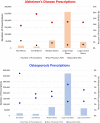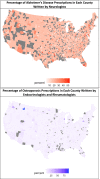Prescribing Alzheimer's Disease treatments by provider type and geographic region: a comparison among physicians, nurse practitioners, and physician assistants
- PMID: 35752783
- PMCID: PMC9233396
- DOI: 10.1186/s12877-022-03176-3
Prescribing Alzheimer's Disease treatments by provider type and geographic region: a comparison among physicians, nurse practitioners, and physician assistants
Abstract
Background: The estimated increase in Alzheimer's Disease (AD) caseload may present a logistical challenge to the US healthcare system. While nurse practitioners (NPs) and physician assistants (PAs) are increasingly delivering primary care to patients with chronic diseases, the nature of their prescribing of AD medications is largely unknown. The primary objective of this study was to compare the prescribing of AD medications across provider types (physician, NP, and PA) and geographic regions.
Methods: We conducted a retrospective cohort study using IBM MarketScan® commercial and Medicare supplemental claims to examine unique AD prescriptions prescribed between January 1, 2016, and December 31, 2019. Parallel analysis of prescriptions for another geriatric condition, osteoporosis (OP), was also conducted for comparison.
Results: A total of 103,067 AD prescriptions and 131,773 OP prescriptions were included in analyses. Physicians prescribed most AD prescriptions (95.65%), followed by NPs (3.37%) and PAs (0.98%). Small differences were identified among individual AD medications prescribed by physicians compared to NP/PAs. NPs/PAs prescribed a significantly higher proportion of AD prescriptions in rural as compared to urban areas (z = 0.023, 95%CI [0.018, 0.028]).
Conclusion: Minimal variation exists in AD prescribing among physicians, NPs, and PAs, but NPs/PAs prescribe more AD prescriptions in rural areas. NPs/PAs, especially in rural areas, may play critical roles in alleviating projected workforce constraints. Further research assessing AD care, health outcomes, and costs by provider type and region is necessary to better guide healthcare workforce planning for AD care.
Keywords: Alzheimer’s Disease; Dementia; Geographic disparities; Prescribing patterns; Provider type; Rural; Urban.
© 2022. The Author(s).
Conflict of interest statement
JY Park is a Postdoctoral Fellow in Health Economics and Outcomes Research (HEOR) with Genentech and the University of Washington Comparative Health Outcomes, Policy, and Economics (CHOICE) Institute.
CJ Wallick is a full-time employee of Genentech.
DL Veenstra has served as a consultant to Genentech.
Figures




Similar articles
-
Prescribing trends by nurse practitioners and physician assistants in the United States.J Am Acad Nurse Pract. 2006 Jun;18(6):291-6. doi: 10.1111/j.1745-7599.2006.00133.x. J Am Acad Nurse Pract. 2006. PMID: 16719848
-
New chronic disease medication prescribing by nurse practitioners, physician assistants, and primary care physicians: a cohort study.BMC Health Serv Res. 2016 Jul 27;16:312. doi: 10.1186/s12913-016-1569-1. BMC Health Serv Res. 2016. PMID: 27464570 Free PMC article.
-
Physician assistant and nurse practitioner prescribing: 1997-2002.J Rural Health. 2005 Fall;21(4):355-60. doi: 10.1111/j.1748-0361.2005.tb00107.x. J Rural Health. 2005. PMID: 16294660
-
A contemporary analysis of medicolegal concerns for physician assistants and nurse practitioners.Leg Med. 1994:133-80. Leg Med. 1994. PMID: 7830478 Review.
-
NP and PA transition to practice: A scoping review of fellowships and onboarding programs.JAAPA. 2023 Dec 1;36(12):1-9. doi: 10.1097/01.JAA.0000991352.36720.09. JAAPA. 2023. PMID: 37943670
Cited by
-
Diagnosis and Management of Alzheimer's Disease in Primary Care: A Real-World Study in Ontario, Canada.J Prim Care Community Health. 2025 Jan-Dec;16:21501319251363156. doi: 10.1177/21501319251363156. Epub 2025 Aug 16. J Prim Care Community Health. 2025. PMID: 40819191 Free PMC article.
-
Demographic, Healthcare Access, and Dietary Factors Associated With Thyroid Hormone Treatments for Hypothyroidism.J Clin Endocrinol Metab. 2023 Nov 17;108(12):e1614-e1623. doi: 10.1210/clinem/dgad331. J Clin Endocrinol Metab. 2023. PMID: 37327351 Free PMC article.
-
Diabetes medication prescribing trends based on provider type and location in the United States.Prev Med Rep. 2024 Dec 12;49:102947. doi: 10.1016/j.pmedr.2024.102947. eCollection 2025 Jan. Prev Med Rep. 2024. PMID: 39802219 Free PMC article.
-
Exploring non-medical prescribing for patients with mental illness: a scoping review.BMC Psychiatry. 2025 May 19;25(1):504. doi: 10.1186/s12888-025-06938-6. BMC Psychiatry. 2025. PMID: 40389900 Free PMC article.
References
-
- 2021 Alzheimer's disease facts and figures. Alzheimers Dement. 2021;17(3):327–406. 10.1002/alz.12328. Epub 2021 Mar 23. - PubMed
-
- Prince M, Wimo A, Guerchet M, et al. The global impact of dementia. An analysis of prevalence, incidence, cost and trends. London: Alzheimer’s Disease International; 2015. World Alzheimer Report 2015.
-
- Liss JL, SeleriAssunção S, Cummings J, Atri A, Geldmacher DS, Candela SF, Devanand DP, Fillit HM, Susman J, Mintzer J, Bittner T, Brunton SA, Kerwin DR, Jackson WC, Small GW, Grossberg GT, Clevenger CK, Cotter V, Stefanacci R, Wise-Brown A, Sabbagh MN. Practical recommendations for timely, accurate diagnosis of symptomatic Alzheimer's disease (MCI and dementia) in primary care: a review and synthesis. J Intern Med. 2021;290(2):310–334. doi: 10.1111/joim.13244. - DOI - PMC - PubMed
Publication types
MeSH terms
Grants and funding
LinkOut - more resources
Full Text Sources
Medical
Miscellaneous

